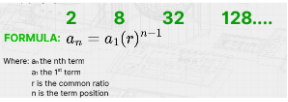MMW Flashcards
1/56
There's no tags or description
Looks like no tags are added yet.
Name | Mastery | Learn | Test | Matching | Spaced |
|---|
No study sessions yet.
57 Terms
Patterns
foundation of mathematics and are present all around us. They give us the ability to discover new ideas, make predictions, and even influence the future.
Patterns of Visuals
often unpredictable, never quite repeatable, and often contain fractals, appealing to the eyes.
Patterns of Flow
flow of liquids, sense of direction, repeatable, recurring.
Patterns of Movement
regular rhythm just like the walk of humans; left right left right rhythm
Patterns of Rhythm
uses beat and is the most basic pattern in nature
Patterns of Texture
uses the sense of touch; literal surface that we can feel, see, and imagine.
Geometric Patterns
consists of a series of shapes/tiles that are typically repeated.
Reflection Symmetry
when the left half of a pattern is the same as the right half.
Line Symmetry or Mirror Symmetry
Other terms for reflection symmetry
Rotational Symmetry
captures symmetries when it still looks the same after some rotation of less than one full turn.
Translational Symmetry
exists in patterns that we see in nature and in man-made objects. Translations acquire symmetries when units are repeated and turn out having identical figures
Fibonacci
numbers appear throughout nature, from the smallest to the largest forms.
Sequence
refers to an ordered list of numbers called terms, that may have repeated values. The arrangement of these terms is set by a definite rule.
Arithmetic Sequence
A sequence that follows a definite pattern; pattern that uses a common difference

Formula for Arithmetic Sequence

Formula for Geometric Sequence
Geometric Sequence
A sequence of numbers that follows a pattern where the next term is found by multiplying a constant called the common ratio.
Harmonic Sequence
The reciprocal of the terms behave like arithmetic sequence.

formula for Harmonic Sequence
Fibonacci Sequence
is an integer in the infinite sequence 1,1, 2, 3, 5, 8, 13,.. of which the first two terms are 1 and 1 and each succeeding term is the sum of the two immediately preceding.
1.618
What is the value of the golden ratio?

What is the formula of Fibonacci Sequence?
Precise, Concise, Powerful
Characteristics of a mathematical language
What symbol is a connective?
+/ plus sign
Expression
mathematical equivalent of an english noun
N sub 0
natural numbers / whole numbers set with zero
N sub 1
natural numbers / whole numbers set without zero
Z
integer numbers set
Q
rational numbers set
R
real numbers set. all rational or irrational numbers mostly are decimal.
C
complex number set, usually in the form a+bi
Unit set
set that contains only one element
Empty set
set that has no element
Finite set
set that the elements in a given set is countable
Infinite set
set that elements has no end or not countable
Cardinal Number
denoted by n; used to measure the number of elements in a given set.
Equal set
said to be equal if both cardinality and the elements are identical
Equivalent set
exact number of element or same cardinal numbers ; 1 to 1 correspendonce
Universal set
set of all elements under discussion
Joint sets
said to be blank if and only if they have common element/s
Disjoint sets
if and only if they are mutually exclusive or if they don’t have common element/s
Roster or tabular method
method of describing a set; done by listing or tabulating the elements of the set
Rule or set-builder method
stating or describing the common characteristics of the elements of the set. a {x|x…}
Proof
rigorous mathematical argument which unequivocally demonstrate the truth of a given proposition.
Proposition
declarative statement that is true or false but not both.
corollary
proposition that follows with little or no proof required from one already proven
Lemma
Lemma short theorem used in proving a larger theorem
Conjecture
conclusion drawn from inductive reasoning; a proposition which is consistent with known data, but has neither been verified nor shown to be false. synonymous to hypothesis also known as an educated guess
Inductive Reasoning
drawing a general conclusion from a repeated observation or limited sets of observation of specific examples.
counterexample
proves the conjecture to be false.
deductive reasoning
drawing general to specific examples or simply from general case to specific case; starts with a general statement or hypothesis and examines to reach a specific conclusion.
Intuition
reliable mathematical belief without being formalized and be proven directly and serves as an essential part of mathematics.
Proof
inferential argument for a mathematical statement
Direct Proof
a mathematical argument that uses rules of inference to derive the conclusion from the premises. if p then q.
Indirect proof
or contrapositive proof; type of proof in which a statement to be proved is assumed false
Proof by counterexample
disproving universal statements
Proof by contradiction
assuming your implication is not true, then deriving a contradiction.